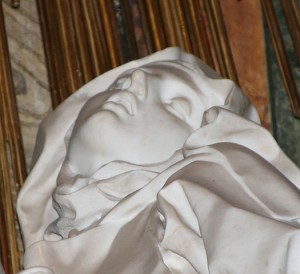 Clare Short recently began formation as a Secular Carmelite, and has been blogging about it. She’s the mother of young children, and the other day she received a message about her vocation from a priest who should know better:
Clare Short recently began formation as a Secular Carmelite, and has been blogging about it. She’s the mother of young children, and the other day she received a message about her vocation from a priest who should know better:
I was recently sent a rather snooty message by a diocesan priest who used to be a Trappist monk. He was telling me that it was basically impossible for me to live a contemplative life in the context of a family home. He told me my children would not find my ‘requirement’ for silence much fun. He also told me it was impossible to be a contemplative without silence.
Clare goes on to explain how she’s been preparing (rather willy-nilly) for a vocation of silence in the midst of noise for the past five years, courtesy of a nasty case of tinnitus. It’s a beautiful story you really should read. (I’ll wait.)
As a Lay Dominican I find Clare’s story interesting because it points out some interesting things about our vocations as tertiaries.*
First, the vocation to be a tertiary is a genuine vocation, a real calling from God. Not everyone is called to it; and those who are called are suited to it, because grace perfects nature. It’s a sign of Clare’s calling as a Secular Carmelite, a contemplative order, that she can find her Carmel deep within, in the middle of her daily life.
Clare’s correspondent is a former Trappist, an order that emphasizes silence. For the record, the Cistercian Order was founded as a reform of the Benedictine order, and the Trappists as a reform of the Cistercians. These people are hard-core. I doubt you could live a First-Order Trappist vocation without all of the external help (including silence) that you can get. But Carmelites are not Trappists; and Secular Carmelites are most especially not First-Order Trappists.
Second, a tertiary’s vocation isn’t simply an attenuated or watered-down version of the First or Second Order’s vocation: it’s a different vocation altogether. It’s frequently a secondary vocation; for married tertiaries, our primary vocation is to our marriage. And it’s always a vocation to be lived out in day-to-day life in the world.
This is to say that it’s simply a part of the vocation of a tertiary to make time for God in the midst of a busy secular life. It’s simply what we do.
And third, to be a Dominican tertiary is a very different thing than to be a Carmelite or Franciscan or Benedictine tertiary. The orders do have quite distinct charisms, and though I love Clare’s description of finding that desert deep within her soul it isn’t anything that I’ve been looking for. Carmelites are made to live in silence; Dominicans, well, you can’t shut us up.
____
* Most of the major religious orders—Benedictines, the Franciscans, the Carmelites, the Dominicans, and so forth—have both men (priests or brothers) and women (nuns or sisters) as consecrated members of the order. And most of them also have what you might call a lay auxiliary: lay people who are attracted to the order’s spirituality and charism, and have formally become members of the order. It used to be that such lay people were said to be Third Orders or tertiaries: the consecrated men were the order’s First Order, the consecrated women were the Second Order, and the affiliated layfolk the Third Order. Some time late last century, the powers that be decided that the “First/Second/Third” terminology was demeaning to the Second and Third Orders, and more or less abolished it.
And then each order adopted its own terminology for their Third Order members. Third-Order Benedictines became Benedictine Oblates. Third-Order Franciscans and Carmelites became Secular Franciscans and Carmelites. And Third-Order Dominicans became Lay Dominicans.
Do you see the problem? There is now no authorized term shorter than “layperson affiliated in some way with a religious order” that applies to all such people. Consequently, I and most people I know have gone on calling them Third-Orders or tertiaries. It’s a nuisance, is what it is.)
____
Photo Credit: Nina Aldin Thune, CC-BY-SA 2.5












